| Pregnancy
Prevention
 p
592-604 p
592-604
 p 175-179 p 175-179

Canine Contraception Intravaginal
device
- This device is no longer marketed.
- It was an Elizabethan idea that really needed a
proper fit to be effective.
Research areas in canine contraception
- Zona antibody
- GnRH antibody
- anti LH
- anti estrogen
- anti androgens
- anti riboflavin
- Prolactin inhibitors
- Hydroxysteroid dehydrogenase inhibitors
- Triazole - non hormone prevents implant
- Gossypol
- Targeted toxins
Mismate
management
Click
Here to see an algorithm on mismate management
or
Click here to open a PowerPoint
picture of the mismate algoritmm
 p 179-188 p 179-188
- If a dog is presented for mismate management
("abortion shot") several questions should be asked before
any therapy is instituted.
- Was the bitch really in heat?
- How long was the bitch gone? In that time could
breeding have happened? Did breeding occur?
- Are pups wanted now or in the future? Why are pups
wanted?
- Was the bitch really in heat?
- Do a vaginal cytology smear to see if the bitch is
really in estrus. If not, then the chance of pregnancy are minimal.
How long was the bitch gone?

- In that time could breeding have happened?
- Since natural breeding takes up to 30 minutes, a
bitch that is gone for only 5 minutes has very little chance of
being bred.
Did breeding occur?

- Check for sperm cells in the vaginal cytology. The
presence of sperm cells definitely indicates that the bitch has been
bred, however their absence does not mean that she has not been
bred.
- Playing
and courtship may be
misinterpreted as mating by
uniformed clients.
Are pups wanted now or in the future?
Why are pups wanted? Is this really a breeding bitch?
Why are pups wanted?
- If pups are not wanted, or wanted for an unfounded
reason (to make the bitch a better dog etc. ovariohysterectomy may
be best alternative. If possible, have the client pay for a non-estrual
surgery now and then return when the bitch is not in heat. It makes
it cheaper for the client and an easier surgery for the
veterinarian.
What are the chances the bitch is actually pregnant?
- In a study performed to look at pregnancy rates of
bitches presented for mismate, 62% of dogs presented after mating
were not pregnant
(Feldman et al. JAVMA, 1994, 202:1855)
- This may be
because the 'breeding" was
misinterpreted by the owner
and the bitch was not
acutally bred.
- If ovariohysterectomy is not an option, then
waiting to determine if the bitch is pregnant is probably the best
alternative. Pregnancy examination can be performed by ultrasound as
early as 16-18 days after the first day of diestrus.
- If the owner wants immediate action, then some
alternatives are available.
Mismate Drugs
Estradiol Cypionate (ECP)

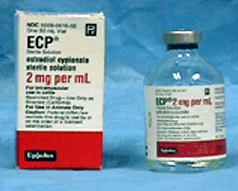

- This
drug is probably gone
from the market now.
-
This is probably the only true mismate drug
available.

- There are very few academicians who will consider
using ECP because of the risks of adverse side effects. When used
properly for the correct clients, however it can be relatively safe
and efficacious. The best article on this is Bowen,
Olson et al. JAVMA, 1985;186:783-788. Click
on the blue text if you want to see the article.
- The dose 44 ug/kg IM given once during estrus to be
the best dose (0.02 mg/lb)
- It is not effective if used in proestrus or in
diestrus, therefore it is essential that the vaginal cytology be
examined.
- It can induce pyometra if given during diestrus, so
be sure the bitch has not entered diestrus when administered.
- Other side effects
- The bitch will show continued estrous signs,
because of the estrogen. It is important that the bitch not be
allowed to breed again.
- Cystic endometrial hyperplasia can also result
after ECP administration.
- Bone marrow suppression can be dose related or
non-dose related. To avoid dose related, do not give a second
injection. Non-dose related bone marrow suppression can be totally
avoided only by never giving ECP injections.
- Pyometra
- No pyometras were seen when the ECP was given
during estrus.
- Treatment failure
- The treatment was 100% efficacious when
administered during estrus. side effects and no failures when given
during estrus.
- Summary: If puppies are wanted it the future and
the client is aware that there is a risk and they are willing to
take it, then ECP offers an inexpensive, efficacious, relatively
safe mismate protocol. However, if the bitch is a valuable breeding
bitch, or a surrogate child, then other alternatives may be more
attractive to both client and veterinarian.

Prostaglandins (PGF) -Lutalyse
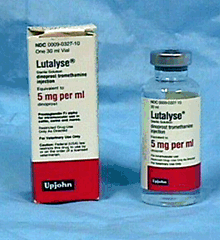
- This is really not a mismate drug, but can be used
before pregnancy is recognized, so it is included here.
- If the bitch is pregnant, then prostaglandins can
be used.
- There are several prostaglandin
products available. Lutalyse most commonly used in the dog.
Prostaglandins were originally not considered to be luteolytic until
last the last third of diestrus (40 or more days), however it is now
known that multiple injections are luteolytic after only the fourth
or fifth day of diestrus. (Oettle et al
Therio 1988:29;757-763). This may be
because the prostaglandin needs to bind to more receptors (if each
corpora lutea has 'N' receptors and there are multiple corpora lutea
in the bitch, then the bitch needs for example 5N receptors bound
with prostaglandin....something that is not attainable with a single
dose due to the side effects of prostaglandin) .
- Oettle used a dose of
250 mcg/kg SQ 4 days starting at day 5-8 of diestrus was 80%
effective. If the treatment failed, the pregnancy was normal.
- Feldman et al. JAVMA, 1994, 202:1855used
a a dose of 0.15 mg/kg, SC, TID for first 1-1½ d, then 0.25 mg/kg
TID and continue until loss is complete.
- Monitor the loss by ultrasound or abortion may not
be complete.
- Feldman currently recommends a dose of 0.10 mg/kg,
SC, TID for first 2 days, then 0.25 mg/kg TID and continue until the
pregnancy loss is complete. It is extremely important that the
pregnancy be monitored or the treatment may fail because of failure
of luteolysis. Progesterone must be <2
ng/ml for 24 hours to result in abortion.
- Side effects include transient diarrhea and
vomiting. These usually subside within 30 minutes. (see
"pyometra" for side effects)


- Atropine (0.1 mg/kg) reduces side effects, but may
also reduce efficacy
- There is also the possibility of circulatory shock,
so it is important that a catheter is in place and fluids are ready
to treat the shock. This too is transient. Generally, side effects
diminish as the treatment protocol continues.
- LSU low dose protocol
- 0.012 mg/kg QID subcutaneously for 5 days (3 pregnant 30 d and 7 non-pregnant bitches treated)
- Progesterone concentration declined by day 3 of treatment
- Day 3 heartbeats still present
- Some brown discharge - no fetal parts seen
- No other real side effects
- Uterus empty at 5 days post treatment
Dexamethasone
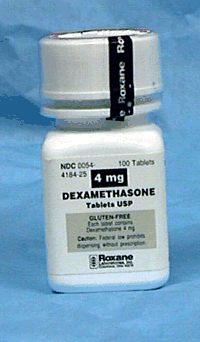 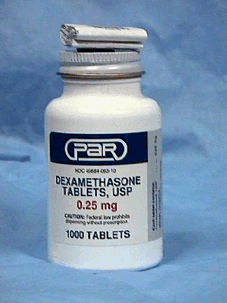
- If the bitch is pregnant, then dexamethasone can be
used.
- A dose of 5 mg BID, IM, for 10 days at 30 days of
gestation aborted 4 bitches 1-3 days after the end of treatment.
- Zone et al. 1995, Therio 43:487
- Zone used 5 bitches at 28 - 51 days of gestation
and administered dexamethasone 0.2 mg/kg, PO, TID for 5 d, then
progressively decreasing dose from 0.16 to 0.02 mg/kg over 5 days
- In 15 bitches dexamethasone was given at a dose of
0.1 to 0.2 mg/kg, PO, BID for 3 doses, then 0.2 mg/kg on days 2 - 5,
then decreasing dose from 0.16 to 0.02 for last 5 doses (total 7.5
d).
- All bitches aborted or resorbed the pregnancy 2-26
days from beginning of treatment.
- We recommend just using the high dose PO BID until
signs of pregnancy have disappeared. Just as in using prostaglandin,
if a protocol is blindly followed without doing pregnancy
examinations, then treatment failures will occur.
- Normal litters have been obtained after this
treatment.
- Side effects include a transient polydypsia and
polyuria that subsided when the treatments were stopped.
- This is the protocol I generally recommend as it is
readily available, cheap and effective.
Induction of abortion
Prostaglandin
(Lutalyse)
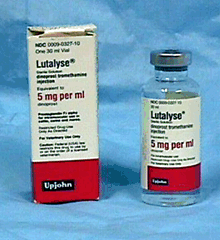
- Use the same as 'mismate'.
- Use at greater than 30 days gestation.
Prolactin antagonists
- Since prolactin is luteotropic and needed to
maintain pregnancy, prolactin antagonists will cause abortion.
- These prolactin antagonists also shorten the
interestrus interval.
- Prolactin antagonists prevent mammary development.
Bromocriptine (Parlodel)
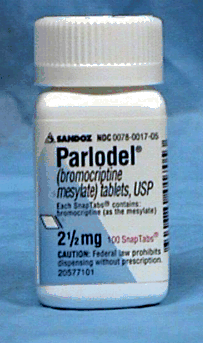
- A dose of 30-100 mcg/kg PO BID 5-6 days at 35-40
days of gestation causes abortion in 3-5 days.
- orally at a dose of 62.5 mg/kg twice daily to dogs
at 43-45 days post ovulation resulted in only 2/4 bitches aborting.
- Bromocriptine may cause dogs to vomit, so it had
not been widely accepted.
- The long term effects on reproduction have not been
studied.
Cabergoline (Dostinex)
- 160
mg
orally once daily given to a 32 kg German Shepherd dog resulted in
abortion after 7 days with no side effects.
- Even
though each dose of cabergoline may be only about $1.80, an initial
investment of around $148 needs to be made to purchase the minimum
package
- Cabergoline is now available in the United States
only in an oral formulation (injectable in Europe)
- Injectable available in Europe
- 1.65
mg/kg
injected subcutaneously for 5-6 days at 25-40 days after the
first mating resulted in abortion for all (5/5) those bitches
greater than 40 days gestation
- only
50% (1/4 at 25 days and 4/6 at 30 days) of those less than 40
days
Cabergoline plus cloprostenol ('Estrumate' a synthetic
prostaglandin)
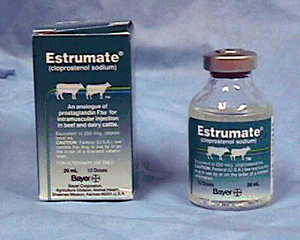
- Onclin et al. 1995, Therio, 43:813.
- Cabergoline (1.65 ug/kg/d, sc) plus cloprostenol
(2.5 ug/kg/d or 1.0 ug/kg/d) starting day 25 after the LH peak
proved 100% effective and had no side effects.
- Cabergoline is now available in the United States
as Dostinex.
- The treatment caused a shortened interestrus
interval.
Other compoundsDCT
(Desacetyl thio-colchicine)
- It has a direct smooth muscle action that causes
abortion 1-2 days after treatment.
- A dose of 2 mg/kg IV or IP after day 30 of
gestation is efficacious.
- Vomiting, diarrhea, and uterine contractions are
side effects.
- The LD50 may be close to therapeutic dose.
- Post-treatment fertility is not affected.
Detrilex
- Luteinizing releasing hormone (LHRH) antagonist
- A dose of 2 mg/kg for 7 days given during
midgestation is effective.
Tamoxifan citrate (NoVadet)
- Tamoxifan has estrogen activity in dogs.
- It has been administered at a dose of 1.0 mg/kg
orally twice a day for 10 days starting either in proestrus, estrus,
or days 2, 15, or 30 of diestrus.
- 100% efficacy for preventing pregnancy when
administration began before day 15 of diestrus
- When administered on day 15 of diestrus or later it
was not effective
- Induced a
33 % incidence of pyometra and endometritis.
Epostane
- Epostane is 3beta-hydroxysteroid
dehydrogenase )
delta 5-4 isomerase inhibitor. It inhibits progesterone synthesis.
- A dose of 2.5 - 5.0 mg/kg PO for 7 days starting on
the first day of diestrus is effective at terminating pregnancy.
RU486 (Mifepristone)

- RU 486 is a progesterone receptor antagonist, so
progesterone is prevented from binding to receptors.
- Oral
administration of mifepristone at a dose 2.5 mg/kg twice daily for
4.5 days starting at day 32 of gestation resulted in 100% (5/5) of
the bitches having a decline in progesterone two days after
treatment started and pregnancy loss with no side effects
around three days after treatment initiation.
- Four
pregnancies were terminated in bitches that were 35-39 days pregnant
using oral drug
- A
dose as low as 8.3 mg/kg and up to 20 mg/kg were administered orally
for one or two treatments and abortion occurred within 2-11 days.
- Mifepristone
is available as a 200 mg tablet in the United States
- not
labeled to terminate pregnancy in the bitch.
- can
cost as much $50 a dose for a 10 kg dog,
- an
initial purchase of $1350 is required to purchase the package
- A dose of 2.5 mg/kg PO BID for 4-5 days starting on
day 32 of pregnancy produces abortion in 3-6 days. A single SQ dose
of 22.7 mg/kg is effective at inducing abortion, however the time to
abortion is not reliable.
|
 Next
Page
Next
Page Canine
Index
Canine
Index











